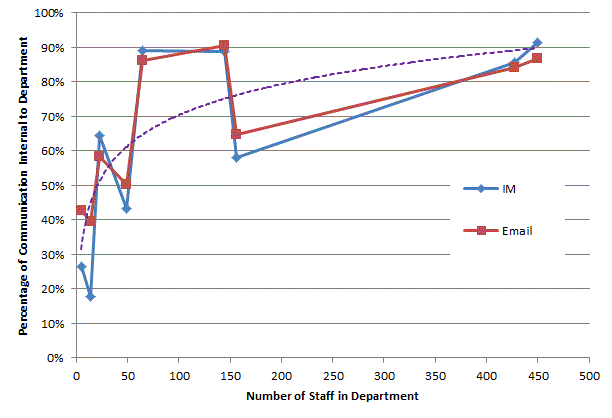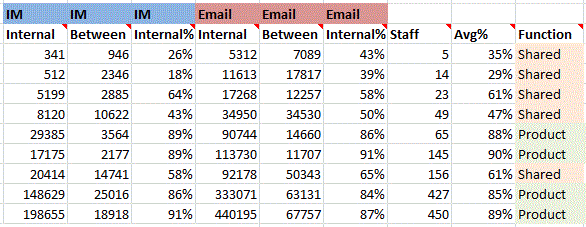Email has long been studied to understand Social Networks. In more recent years organisations have embraced internal Instant Messaging, such as Microsoft Lync. Any organisation that wants to understand the Social Networks, and other insights communication data might reveal, will want to know if analysis of Instant Messaging logs can enhance insight from other sources like Email. Depending on an organisations culture Email and Instant Messaging (IM) may represent different levels of trust or formality; revealing a cultural meaning of Email versus IM is beyond this discussion but anyone who has spent a reasonable amount of time in an organisation will probably be aware of that organisation’s cultural tendencies in communications.
My initial question is does IM show us anything Email does not? Starting at a macro view I revisited the inter-departmental communications: there was not much difference when looking at the IM traffic versus the Email traffic (when viewed as percentages of overall traffic) but there did seem to be some potentially significant differences in the volumes of communications internal to a department (I did not previously examine these numbers).
To further explore differences between IM and Email, at a macro level, I have looked at the percentage of internal departmental communication compared to total communication emanation from the department. Here is a chart of the results:
For the purposes of looking at differences between IM and Email, this chart shows there does not seem to be much difference in the ratio of use between intra- and inter-departmental communications. My conclusion, so-far, is that there does not seem to be significant differences in the use of IM versus Email at this level.
As an aside, the above graph does seem somewhat inconsistent in the function between department size and the percentage of communication that is internal. Looking at the purpose of each department they can be categorised as either ‘Product’ (focussed on selling and servicing a product line) or ‘Shared’ (e.g. HR, Accounts) and these seem to fall neatly into those with an internal communications level below 70% (Shared) and above 80% (Product); here is a table of the data:
As this is leaving my discussion of differences between Email and IM (this shows very little) I’ll explain more in another post.


 Follow
Follow
Pingback: Intradepartmental Communications as a Percentage of Total Departmental Communication | Robert Gimeno's Adventures in Data Science
Pingback: Email vs. Instant Messaging for Social Network Analysis, Round 2 | Robert Gimeno's Adventures in Data Science